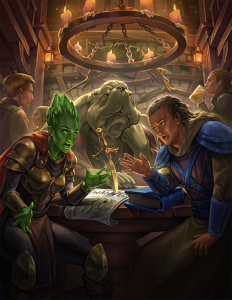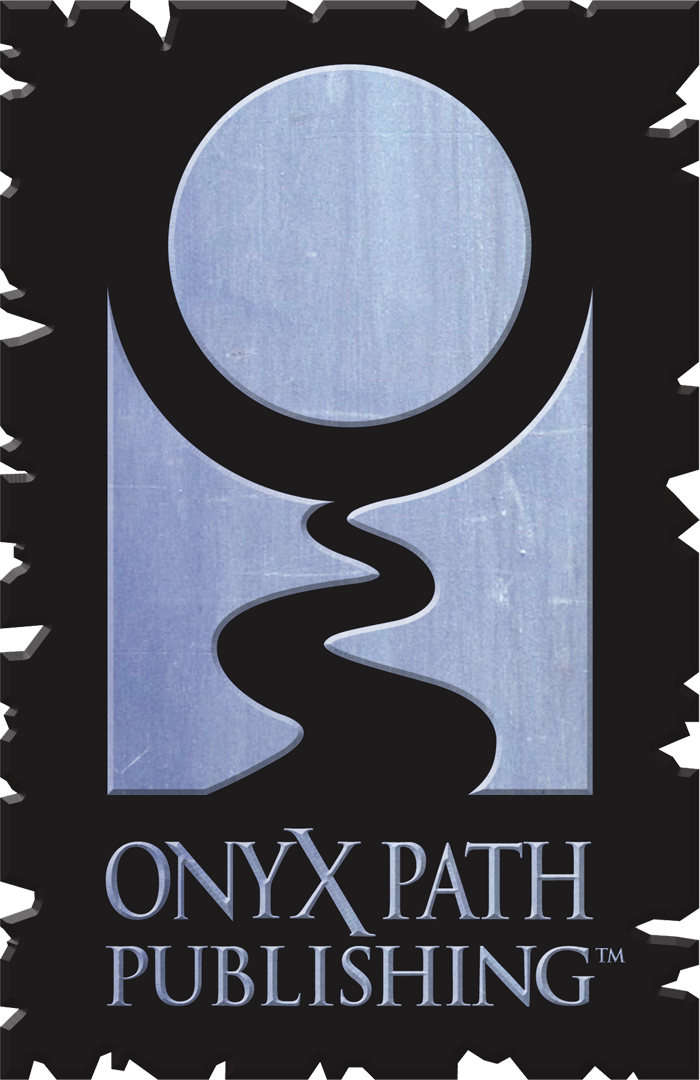As we mentioned in the previous Trinity Continuum: Anima excerpt, games are a popular way for the traumatized population of 2084 to blow off some steam. Here’s a little bit about the most popular game in 2084, Terra Surge.

The most played game in the world right now is Terra Surge, and it’s like nothing anyone has ever experienced. Almost everyone with Glass plays it, even if they can only afford the free version, littered with in-game ads. Words like “game” and “play” are holdovers from the previous decades’ MMORPG culture, and while Terra Surge has roots in traditional fantasy gaming, it offers so much more: a set of narrative AIs, called Narrators, that ensure each person experiences exactly what they want or need, with fully customizable strongholds, and a completely immersive — and expansive — virtual world full of fantastic creatures and landscapes.
Starting Terra Surge
The only times a player sees their anima as a 3D model outside of themselves, rather than as the skin they inhabit, is during the character creation process and on the selection screen, along with in any in-game reflective surfaces, of course. The first choice in the game is picking which of the six peoples an anima will represent:
- Churovians are an aquatic people, made of uplifted fish, octopuses, and other ocean-dwelling creatures, who use strange technology.
- Humans look like typical Earth humans, and they are arranged into large clans; they currently live in lands that cannot sustain them forever.
- Kum Deri are large, bestial, and hardy desert dwellers who are covered in short fur and are resistant to poison. They are also excellent storytellers.
- The Quell, an insectoid people, are subterranean dwellers who can control non-sapient creatures.
- Sentients have mysterious, ghost-like abilities, and are a recent addition to Synestia. They appear as possessed or sentient dolls, mannequins, and stranger things.
- Veer are feathered bird people who value scholarship and tend toward agility; they are excellent at leaping and can glide short distances.
Once a player selects their people, they get to customize their anima. Though some restrictions are in place regarding height and size (depending on the people), and basic features, everything else can be personalized. There are no restrictions based on gender, and all genders are playable. Skin color, eye color, hair, fur, voice, scars, makeup, basic clothing — right down to the fingernails, literally everything can be tweaked. After all, this is more than just a character on a screen; this is the player’s new body. It’s what they use to interact with other players, to fight and adventure and possibly even romance; it’s them, and they have to feel good walking around in their anima. Some players build for brawn, some for beauty, and some for both or neither, but if a player can imagine their character looking or sounding a certain way, their character probably can.
While the choice of peoples informs from whence the anima’s family came, it doesn’t inform their starting area, though it’s suggested new players start in their ancestral homeland for a truly immersive introduction into their anima’s culture. After customizing the anima, a map of Synestia pops up, with the people’s regions highlighted, along with any available starting areas.
Traditionally, the Kum Deri are from the northeastern deserts, the Veer live and learn among the ruins of a long-dead civilization on the southeast, and the Sentients came into existence a few years ago in the southwestern deadlands. Humans live in the south, stuck between the Sentients and the Veer — at seemingly futile war with both. The Quell (p. XX) originally broke the surface world in overwhelming numbers all over Synestia in an attempt to flee a subterranean enemy, and now they claim the previously uninhabited plateaus of the northwest as their homes. The Churovians have access to all the seas and oceans via underground tunnels and caverns; some are naturally occurring, and others they dug over decades.
The second major choice a player makes is their class. They can choose their class after or during anima customization. There are two main types of classes, but each includes multiple subclasses with even more options after that. Highlighting a class displays a short paragraph describing its concept, history, and basic abilities. It also includes a portion of text explaining the currently highlighted people’s perception of the class. For more in-depth anima creation, refer to Chapter Seven: Anima Creation.
The first type of class is the Planars, people whose souls are infused with power from a different plane. Planar players may choose between the crafty and mobile boundless (p. XX), the fierce and fiery fearless (p. XX), or the life-givers and healers known as the muses (p. XX). Those are the three currently playable planar classes out of nine which exist in the lore.
Non-planar classes have their own extraordinary skills or knowledge that allows them to match Planars’ power level. Channelers (p. XX) are students of the esoteric who can tap into the ether to manifest extremely powerful spells with unexpected results. Mages (p. XX) are expert thaumaturgists who can channel energy from any planes into powerful spells and attacks.
The UI
The game doesn’t make use of a traditional overlaid user interface, though individual players can customize their UIs as they wish. Most players, at the very least, keep a minimap somewhere in their field of vision to track enemies, landmarks, and direction. Other players don’t mind a crowded interface, and keep their stats, reputation, quest trackers, and achievements up at all times. Anything “on screen” or part of the UI is controlled by gestures, voice commands, or thought, at the individual player’s discretion. Different animas may have unique setups, or a player can import their settings from a prior character to a new one.
The exception to the lack of UI is inventory management. Every anima is equipped with a void satchel, though its look and feel are up to the player and their gear. Anything put in the satchel doesn’t increase its weight, and players can expand their 40-slot starting inventory through early-game quests (each slot holds one item or a collection of smaller items, like coins). When a player opens their satchel, they see their gear in a pop-up window and can arrange it as needed. The inventory is manipulated by hand and is also customizable based on player preference. Some players use many small pouches to hold various reagents and materials, while others just use one large bag and organize it as they wish. The inventory shows everything the user carries in a typical, grid-based system, and is also the interface through which one changes their equipped gear.
There are other available pop-ups, including a politics window that shows which NPC factions are nearby and if they are hostile or agreeable to the player based on past interactions. For a faction to show up, they must have been encountered at least once. There is also a character screen that shows the player’s levels, stats, and skills. When leveling up, this is where a user spend experience to unlock a skill’s features.
Entering Synestia
No two introductions to Synestia are alike. Once a player installs Terra Surge on their Glass and creates their character, the game’s Narrator AIs (see p. XX) comb through the user’s personal history and generate an opening scene based on its assessment of that player’s personality from their net usage. If the user spends a lot of time on dating sites but isn’t in a relationship, a Narrator generates an NPC the player likely finds attractive, who then sends them on a quest. If it’s someone who reads old sword-and-sorcery novels or who is simply a thrill seeker, they’re thrown into an epic battle scene within seconds. The goal is to hook the player immediately with something familiar and get them used to the game’s basic mechanics. Terra Surge even knows how much they use Glass. A frequent user’s senses get engaged fully almost immediately, while someone new to the platform experiences a gentler tutorial segment.
After the initial scenes, and once the player is familiar with basic interactions, the Narrators assess all their choices and move on, procedurally generating the next encounter, a town to hang out with other players and NPCs, or the entrance to their stronghold. Some players have sunk years of their life into decorating, busking, or hosting virtual parties without ever slaying so much as a mouse, while others crave terrifying encounters with the most vicious monsters or webs of political machinations. Synestia truly offers something for every play style.
Whenever a player wants their anima to do something, they simply do it in the real world, with Glass filling in the details in their brain. Every object in the game looks, feels, sounds, smells, and tastes as it would if it were real. When an anima draws their sword, the player feels it in their hand. If an anima romances an NPC or another player, the kisses feel real, too — among other things, if all parties consent.
Consent is a major part of the MMO’s success. The NPCs won’t flirt with a player who doesn’t wish it, and if a player makes another player uncomfortable, a Narrator AI can gently separate them, replacing both with indistinguishable NPCs who either politely disentangle from the situation or, in the case of a persistent jerk, vanish suddenly through a portal or something equally dramatic. If a player never draws a weapon or uses an offensive spell, or gets distressed when they have to do so, the game will stop sending creatures or bandits their way. If that same player seems bored and maybe up for more adventure later in their career, the AI can ramp the danger back up. Player-versus-player combat (PvP) is likewise an opt-in system, though in active war zones everyone is flagged for it after a short warning period where they can turn their animas around.
Trinity Continuum: Anima can be preordered on BackerKit.
